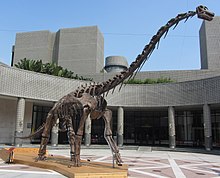Somphospondyli is an extinct clade of titanosauriform sauropods that lived from the Late Jurassic until the end of the Late Cretaceous, comprising all titanosauriforms more closely related to Titanosauria proper than Brachiosauridae. The remains of somphospondylans have been discovered on all continents.
| Somphospondylans Temporal range: Late Jurassic to Late Cretaceous,
| |||
|---|---|---|---|

| |||
| Skeleton of Qiaowanlong | |||
| Scientific classification | |||
| Domain: | Eukaryota | ||
| Kingdom: | Animalia | ||
| Phylum: | Chordata | ||
| Clade: | Dinosauria | ||
| Clade: | Saurischia | ||
| Clade: | †Sauropodomorpha | ||
| Clade: | †Sauropoda | ||
| Clade: | †Macronaria | ||
| Clade: | †Camarasauromorpha | ||
| Clade: | †Titanosauriformes | ||
| Clade: | †Somphospondyli Wilson & Sereno, 1998 | ||
| Subgroups | |||
| |||
Classification
editThe group has officially been defined under the PhyloCode as the largest clade containing Saltasaurus loricatus, but not Giraffatitan brancai.[1] Features found as diagnostic of this clade by Mannion et al. (2013) include the possession of at least 15 cervical vertebrae; a bevelled radius bone end; sacral vertebrae with camellate internal texture; convex posterior articular surfaces of middle to posterior caudal vertebrae; biconvex distal caudal vertebrae; humerus anterolateral corner "squared"; among multiple others.[2]
The following cladogram depicts the reference phylogeny used to defined Somphospondlyi under the PhyloCode.[1]
| Somphospondyli | |
References
edit- ^ a b Silva Junior, Julian C. G.; Martinelli, Agustín G.; Iori, Fabiano V.; Marinho, Thiago S.; Hechenleitner, E. Martín; Langer, Max C. (2021-04-29). "Reassessment of Aeolosaurus maximus, a titanosaur dinosaur from the Late Cretaceous of Southeastern Brazil" (PDF). Historical Biology. 34 (3): 403–411. doi:10.1080/08912963.2021.1920016. ISSN 0891-2963.
- ^ Mannion, P.D.; Upchurch, P.; Barnes, R.N.; Mateus, O. (2013). "Osteology of the Late Jurassic Portuguese sauropod dinosaur Lusotitan atalaiensis (Macronaria) and the evolutionary history of basal titanosauriforms". Zoological Journal of the Linnean Society. 168: 98–206. doi:10.1111/zoj.12029.